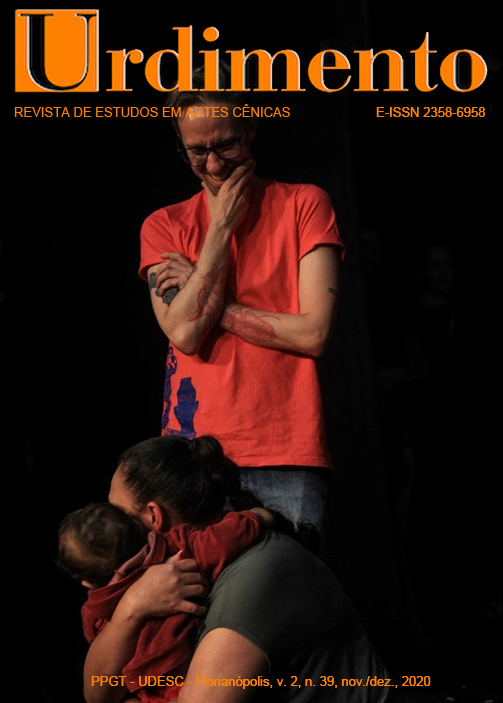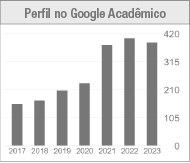Que pasa cuando te miro: el espacio de teatro íntimo en prisión para presos y voluntarios
DOI:
https://doi.org/10.5965/14145731033920200110Palabras clave:
Teatro en prisión, Artes penitenciarias, Voluntarios en prisión, Rehabilitación, Artes de correcciónResumen
A pesar de los crecientes estudios de voluntarios de teatro y prisiones, hay poca investigación que analice la experiencia teatral de la prisión a través de los ojos tanto de voluntarios externos como de prisioneros participantes. Este artículo busca tejer las voces de los coautores para explorar experiencias compartidas del aula de teatro carcelario. Estas experiencias, descritas como "mágicas" y "trascendentes", dependen de que el voluntariado navegue con éxito por la entrada de la prisión. El espacio del aula del teatro de la prisión se convierte entonces en un refugio relacional donde tanto los presos como los voluntarios pueden sentirse bienvenidos y aceptados, vistos no como otros, sino como esenciales.
Descargas
Citas
ABBOTT, J. H. In the Belly of the Beast: Letters from Prison. New York: Vintage Books, 1978.
ABRAMS, L., HUGHES, E., INDERBITZIN, M., & MEEK, R. (Eds.) The Voluntary Sector in Prisons: Encouraging Personal and Institutional Change. London: Palgrave Studies, 2016.
ARMSTRONG, R. Trusting the untrustworthy: the theology, practice, and implications of faith-based volunteers’ work with ex-prisoners. Studies in Christian Ethics, v. 27, n. 3, p. 299-317, 2014.
BREWSTER, L. The impact of prison arts programs on inmate attitudes and behavior: a quantitative evaluation. Justice Policy Journal, v. 11, n. 2, p. 1-28, 2014.
CHELIOTIS, L. (Ed.). The Arts of Imprisonment: Control, Resistance and Empowerment. Ashgate Publishing, 2012.
COHEN-CRUZ, J. Engaging Performance: Theatre as Call and Response. Florence: Routledge, 2010.
CREWE B., WARR, J., BENNETT, P., SMITH A. The emotional geography of prison life. Theoretical Criminology, v. 18, n. 1, p. 56-74, 2014.
CULLEN, F. The twelve people who saved rehabilitation: how the science of criminology made a difference. Criminology, v. 43, n. 1, p. 1-42, 2005.
DILLARD, A. The Writing Life. New York: Harper Perennial, 2013.
DWECK, C. Mindset: The New Psychology of Success. New York: Ballantine Books, 2006.
FESETTE, N. & LEVITT, B. Pedagogies of self-humanization: collaborating to engage trauma in the Phoenix Players Theatre Group. Teaching Artist Journal, v. 15, n. 3-4, p. 100-113, 2017.
FOUCAULT, M. Discipline and Punish: The Birth of the Prison. New York: Pantheon, 1977.
FOUCHÉ, C., & LUNT, N. Nested mentoring relationship: reflections on a practice project for mentoring research capacity amongst social work practitioners. Journal of Social Work, v. 10, n. 4, p. 391-406, 2010.
FREIRE, P. Pedagogy of the Oppressed. New York: Continuum International Publishing Group, 1970.s
GOFFMAN, E. Asylums: Essays on the social situation of mental patients and other inmates. New York: Anchor Books, 1961.
HAMER, K. Navigating boundaries, weaving worlds: U.S. practitioners’ experiences of running theatre programmes in prisons. Cambridge, 2019. Thesis (Masters) – University of Cambridge.
LIEBLING, A. Can human beings flourish in prison? PPT Lecture, London, 29th May, 2012. Available at <http://www.artsevidence.org.uk/media/uploads/evaluation-downloads/can-human-beings-flourish-in-prison---alison-liebling---may-2012.pdf>.
LUCAS, A. Prison Theatre and the Global Crisis of Incarceration. New York: Methuen Drama, 2020.
MORAN D. Carceral geography and the spatialities of prison visiting: visitation, recidivism, and hyperincarceration. Environment and Planning D: Society & Space,
v. 31, n. 1, p. 174-190, 2013.
SIMPSON, E., MORGAN, C., & CAULFIELD, L. S. From the outside in: narratives of creative arts practitioners working in the criminal justice system. The Howard Journal of Criminal Justice, v. 58, n. 3, p. 384-403, 2019.
SMITH, C. What is a Person? Rethinking Humanity, Social Life, and the Moral Good from the Person Up. University of Chicago Press, 2010.
TEWKSBURY, R. & COLLINS, S. Prison chapel volunteers, Federal Probation, v. 69, n. 1, p. 26–30, 2005.
TEWKSBURY, R. & DABNEY, D. Prison volunteers: profiles, motivations, satisfaction. Journal of Offender Rehabilitation, v. 40, n. 1-2, p. 173-183, 2004.
TOFTELAND, C. The Keeper of the Keys. In: SHAILOR, J (Ed.) Performing New Lives: Prison Theater. London: Jessica Kingsley Publishers Ltd., 2011, p. 213-230.
TOMCZAK, P., & ALBERTSON, K. Prisoner relationships with voluntary sector practitioners. The Howard Journal of Crime and Justice, v. 55, n. 1–2, p. 57-72, 2016.
TURNER, V. Liminal to liminoid, in play, flow, and ritual: an essay in comparative symbology. Mediações: Revista de Ciências Sociais, v. 17, n. 2, p. 214–257, 2012.
VAN DER KOLK, B. A. The Body Keeps the Score: Brain, Mind, and Body in the Healing of Trauma. New York, NY: Penguin Books, 2014.
VAN MAANEN, K. Miss Spent: A drama project for young women at the Josephine Butler Unit, HMP Downview. Evaluation Report. Available at: <http://www.clinks.org/assets/ files/Miss%20Spent%20report%20final.pdf>.
ZELON, H. The Shakespeare redemption: Inmates in a Kentucky prison grapple with the truths of human existence. American Theatre v. 18, no. 8, p. 32–135, 2001.
Descargas
Publicado
Cómo citar
Número
Sección
Licencia
Derechos de autor 2020 Urdimento - Revista de Estudios en Artes Escènicas

Esta obra está bajo una licencia internacional Creative Commons Atribución 4.0.
Declaración de Derecho de lo Auctor
Los artículos publicados por la revista son de uso gratuito. Los derechos de autor son todos cedidos a la revista. Los artículos cuyos autores son identificados representan la expresión del punto de vista de sus autores y no la posición oficial de la revista Urdimento. El autor o los autores se comprometen a que publiquen material referente al artículo publicado en la Revista Urdimento mencionar dicha publicación de la siguiente forma:
"Este artículo fue publicado originalmente por la revista Urdimento en su volumen (poner el volumen), número (poner el número) en el año de (poner el año) y puede ser accedido en: http://www.revistas.udesc.br/index.php/urdimento
Este periódico utiliza una Licencia de Atribución Creative Commons - CC - BY 4.0.



